We pivoted from searching from one rare wren to another. From the oversized and gregarious Giant Wren, to the undersized and skulky Nava's Wren.
The Nava's Wren only lives along limestone outcrops in the shade of humid, evergreen forest. It spends its days scampering over thes rocks in search of juicy, invertebrate morsels found within the crevices. Birdlife International estimates that less than 7,000 Nava's Wrens exist in the world. This is because the global range is relatively small due to the species's unique geographic requirements, and because most of the forest within this tiny landmass has already been cut down. Fortunately, the Nava's Wren can survive in small forest patches, but these keep getting smaller and more fragmented as the human population expands its resource use. One large protected area found in the heart of the Nava's Wren range is called El Ocote; the problem is that the specific limestone habitats are not widespread there. The Nava's Wren is listed as Vulnerable and this ranking is unlikely to be improved in the coming decades.
 |
| Limestone rocks - Armando Zebadua area, Chiapas, Mexico |
Most birders who wish to see the Nava's Wren do so in one of two areas: either the forest near the town of La Esmeralda in the western part of the species range, or the entrance road to the town of Armando Zebadúa in the eastern portion. We chose the latter site, "Navalandia".
 |
| Armando Zebadua area, Chiapas, Mexico |
We visited Navalandia on two occasions: first, on the morning of November 24th, and again on the 27th. I'll cut to the chase and mention that we saw a single Nava's Wren, in two mornings of trying. The views were good (for around 10 seconds) as it popped around the base of some limestone boulders, but I stupidly did not go for my camera. By the time that I was satisfied with my look and traded my bins for the camera, the bird slipped behind a boulder and was never seen again. That epic fail prompted the second visit, upon which we did not see a single Nava's Wren. However, we heard quite a few of them - at least 4 individuals during this second trip. This species has been "taped out" here, meaning it no longer responds to playback. In fact, playing recordings causes the Nava's Wrens to go silent. The best strategy is to listen for the distinctive calls notes of the wrens and then try to spot them (without being tempted to play tape - it will not work here!).
 |
| Lesson's Motmot - Armando Zebadua area, Chiapas, Mexico |
The other range-restricted bird that we sought out at Navalandia was the Long-tailed Sabrewing. This species was a little more accommodating and we saw a few blast by. Only one perched long enough for a few low-quality photos. For a hummingbird, it is not that exciting, though it does have an intriguingly long tail that it flashes around as it hovers in front of flowers.
 |
| Long-tailed Sabrewing - Armando Zebadua area, Chiapas, Mexico |
Since this was our first time birding humid lowland forest in Mexico, the new species for our Mexico list came in fast. One that I was particularly happy with was the Rufous-breasted Spinetail. Spinetails are always fun to watch, though they can be impossibly sneaky in thick bamboo vegetation. The Rufous-breasted was a new one for Laura. My only previous encounter was a heard-only bird in Guatemala; the excellent views of this one were greatly appreciated! If only my photos were as good...
 |
| Rufous-breasted Spinetail - Armando Zebadua area, Chiapas, Mexico |
An unexpected lifer that appeared during the mid-morning of November 24 was a sharp Fan-tailed Warbler. Some have said that it appears as if the bird's tail is only loosely attached, as it flips from side to side. An apt descriptor! This needs to be seen to be believed; my photos do not capture this at all.
 |
| Fan-tailed Warbler - Armando Zebadua area, Chiapas, Mexico |
Mid-morning on a clear day always brings the lizards, butterflies and other solar powered creatures out of the woodwork. We experienced this on our first visit here, though the second was clouded over for its duration.
 |
| Rose-bellied Lizard (Sceloporus variabilis) - Armando Zebadua area, Chiapas, Mexico |
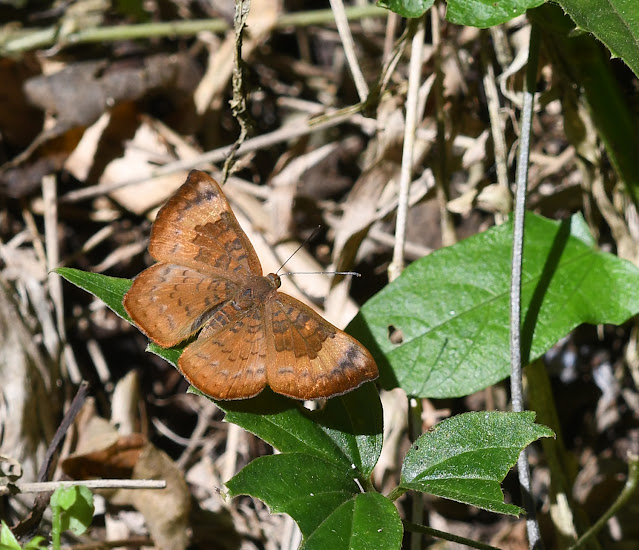 |
| Falcate Emesis (Emesis tenedia) - Armando Zebadua area, Chiapas, Mexico |
 |
| Lamplight Altinote (Altinote ozomene) - Armando Zebadua area, Chiapas, Mexico |
 |
| Longwing Crescent (Eresia phillyra) - Armando Zebadua area, Chiapas, Mexico |
 |
| Turquoise Emperor (Doxocopa laurentia) - Armando Zebadua area, Chiapas, Mexico |
Eagle-eyed Laura even noticed a serpentine shape, resting quietly on the shoulder of the road. I foolishly thought that I had a chance at catching the racer. It shot off into the thick vegetation quicker than I could blink.
 |
| Dryad Snake (Mastigodryas melanolomus) - Armando Zebadua area, Chiapas, Mexico |
In our two visits to Navalandia we noted around 75 bird species. Birdsong was less than I had hoped and the cooler temperatures on the second visit also seemed to quiet the activity. In this rich environment, 100 species should be doable in a morning.
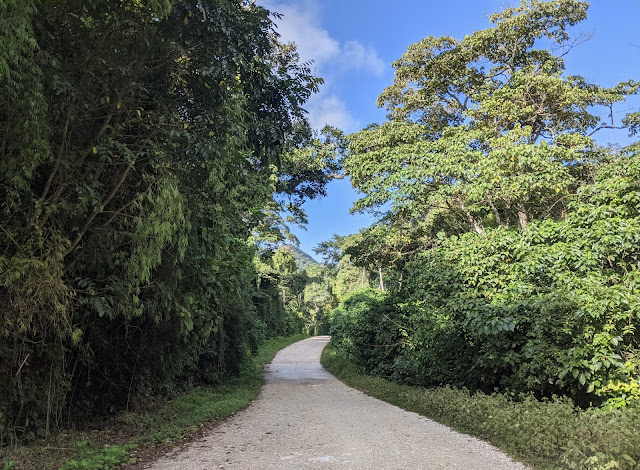 |
| Armando Zebadua area, Chiapas, Mexico |
Some of the other standouts from our visits included Crimson-collared Tanager, Azure-crowned Hummingbird, White Hawk, Ruddy Woodcreeper, Buff-throated Foliage-gleaner, Long-billed Gnatwren, Slate-coloured Solitaire, White-winged Tanager, Orange-billed Sparrow, Yellow-billed Cacique and both species of ant-tanagers.
 |
| White Hawk - Armando Zebadua area, Chiapas, Mexico |
 |
| Morelet's Seedeater - Armando Zebadua area, Chiapas, Mexico |
November 25, 2021
The Grand Canyon in the southwestern United States may be the most famous gorge in North America, but I would argue that Mexico has quite a number of its own impressive canyons. We visited one of these - Cañon del Sumidero - on November 25.
Our goal was, in part, to view the awesome canyon but you could guess that I had ulterior motives as well. Those being the Belted Flycatcher, Flammulated Flycatcher and Slender Sheartail. The gates for the national park do not open until 8 AM. This allowed Laura and I to sleep in at our accommodations in Tuxtla Gutiérrez. We were the second car in the park.
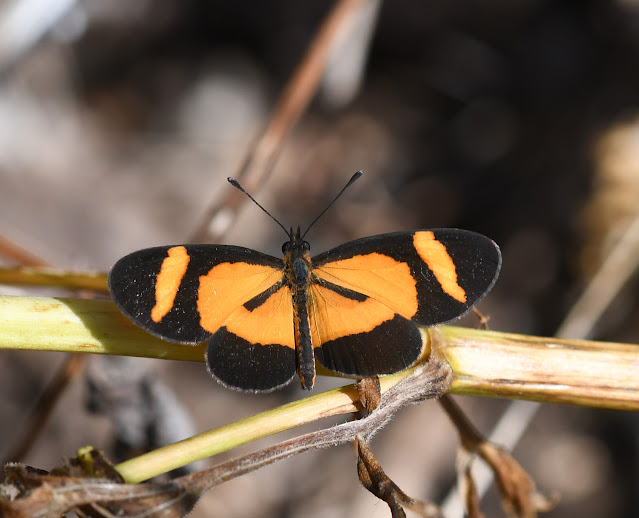 |
| Microtia elva - Cañon del Sumidero, Chiapas, Mexico |
I had sleuthed online the night before and settled on a particular trail to explore first, before the temperatures got too warm. We parked at a small lot just off the paved road (at 16.803214, -93.091147) and walked in through the dry forest.
 |
| Cañon del Sumidero, Chiapas, Mexico |
Even though the best hour and a half of the morning was behind us, we worked hard to catch up. The birding was pretty good - White-eyed Vireo, Plain-capped Starthroat and Cabanis's Wren were quickly accounted for.
 |
| Plain-capped Starthroat - Cañon del Sumidero, Chiapas, Mexico |
I clued into the call notes of a Belted Flycatcher from beside the trail. Minutes later, we were eyeing two of them up. This handsome little flycatcher is only found in a small region of southern Mexico, Guatemala, and El Salvador. I had seen one on my previous Guatemala trip but it was a new one for Laura. We enjoyed watching the spiky-crested little flycatcher belting out his song - a clear Bird Of The Day winner for both of us.
 |
| Belted Flycatcher - Cañon del Sumidero, Chiapas, Mexico |
The Flammulated Flycatcher was another target. We had heard them a few days earlier at Parque Nacional Huatulco, but actually seeing one was the morning's goal (for me at least!). Again, I was stymied. At least three birds vocalized at different points along the trail but I was unable to actually lay eyes on one.
 |
| Adelpha iphicleola - Cañon del Sumidero, Chiapas, Mexico |
With our birding itch scratched, Laura and I drove the rest of the way to the various lookouts by the famous canyon. It was pretty impressive, the scale difficult to capture in photos.
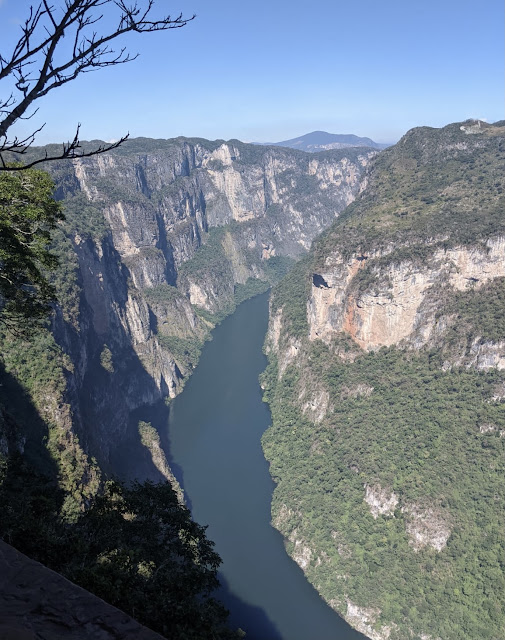 |
| Cañon del Sumidero, Chiapas, Mexico |
The height of the canyon is nearly 1 km at certain points. This really becomes apparent when Neotropic Cormorants or American White Pelicans cruise up the river, appearing as mere specks down below. One option for tourists is to take a boat along the river. We opted against this as we didn't really feel like being jammed into a small boat with 20 others during COVID-19 and we had read some negative things about these tours such as the abundance of garbage in the river.
 |
| Cañon del Sumidero, Chiapas, Mexico |
The Slender Sheartail is sometimes observed as it feeds on flowers in the canyon. The final lookout, Mirador Los Chiapas, is the main go-to spot for birders seeking out this species. The problem, is that November is not an ideal time to find the correct flowers in bloom; successful birders typically find this species between January and March. We gave it our best shot but fell short. Again, you can't get them all!
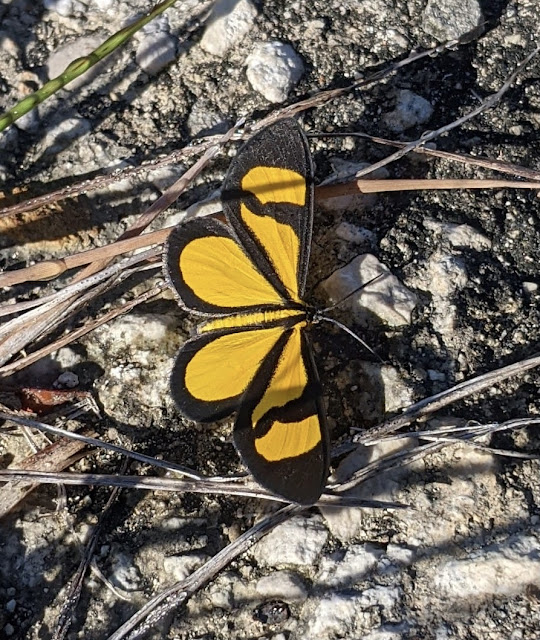 |
| Smicropus laeta - Cañon del Sumidero, Chiapas, Mexico |
As the sun rose high in the sky and the busloads of tourists kept arriving, we hit the road and headed east to the city of San Cristobal de las Casas.
























No comments:
Post a Comment